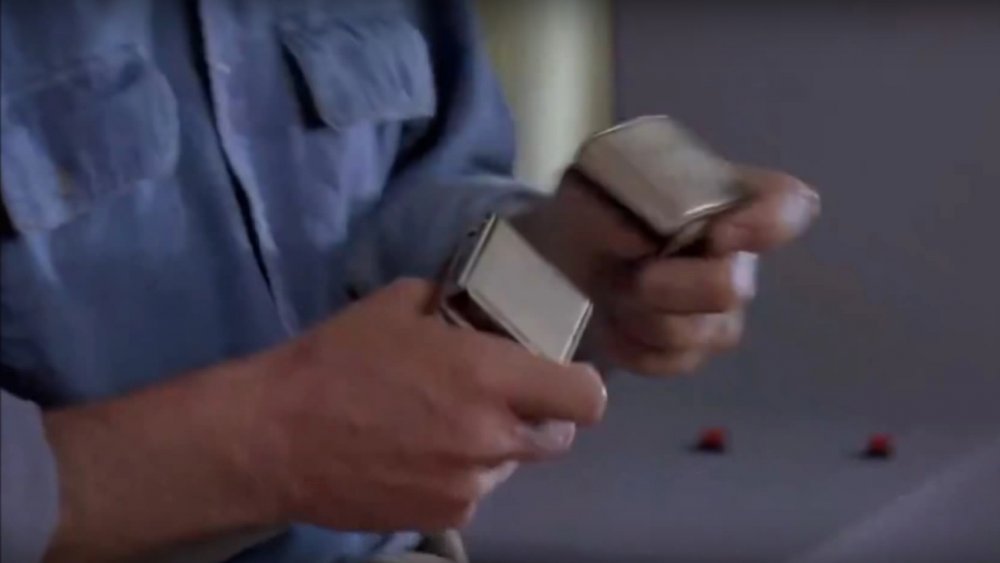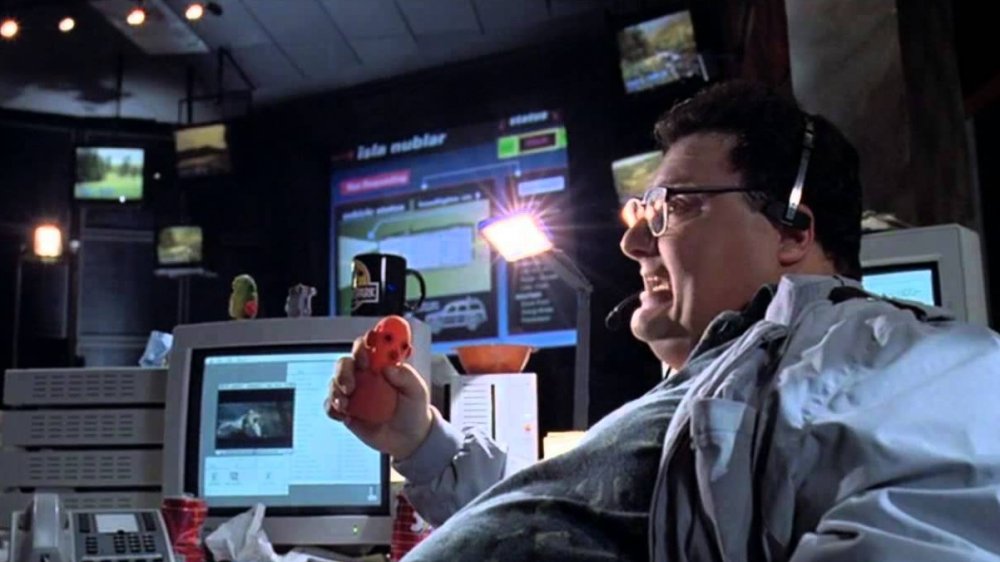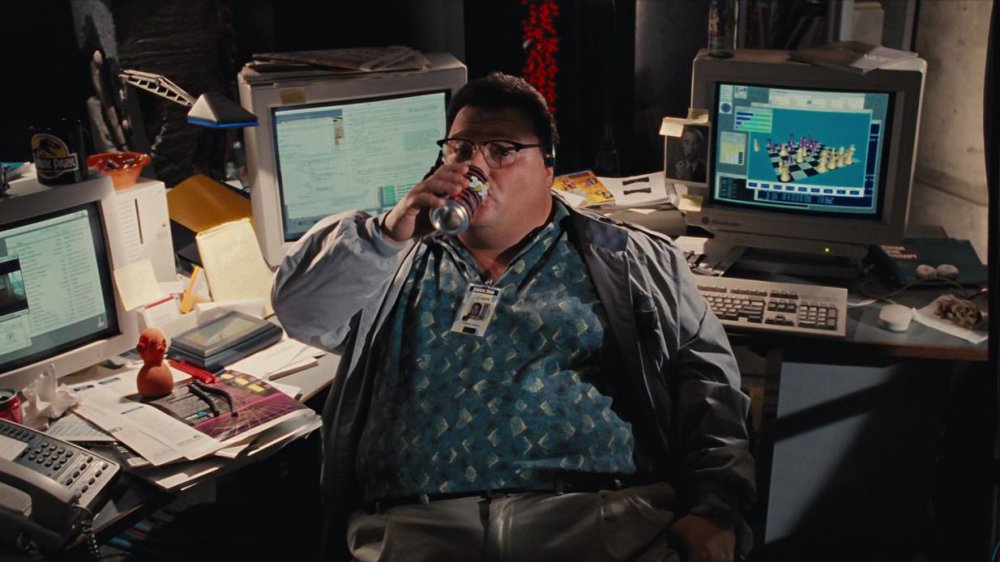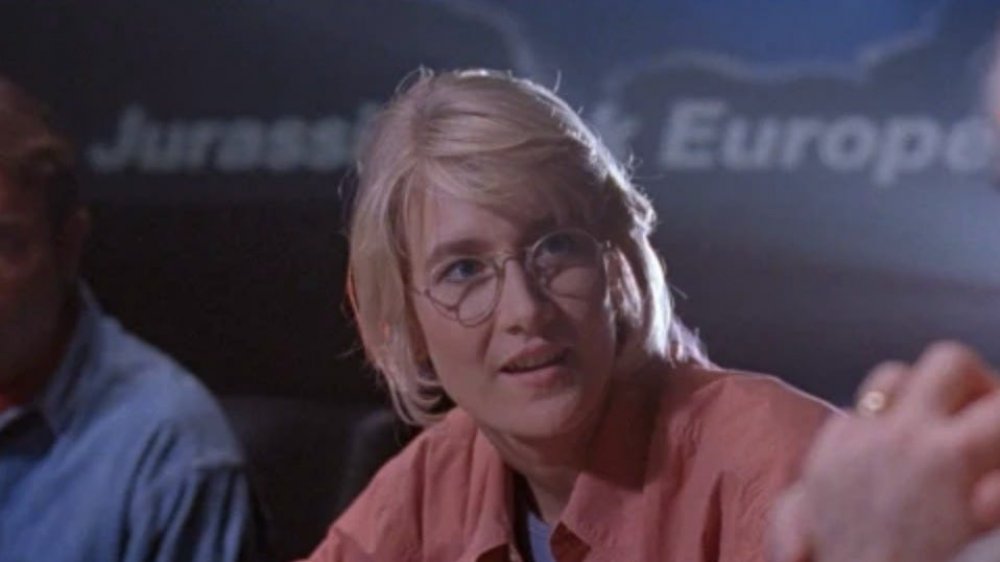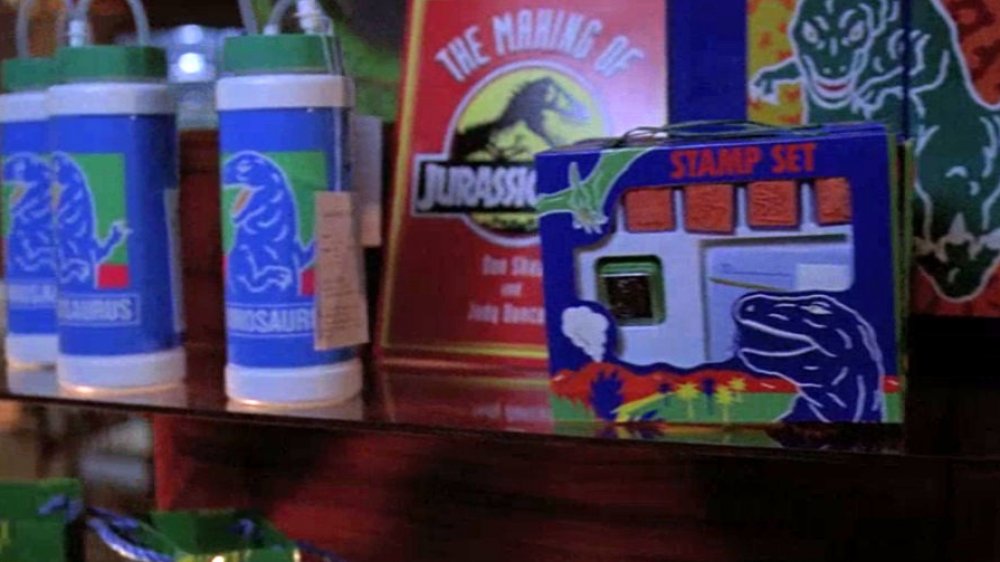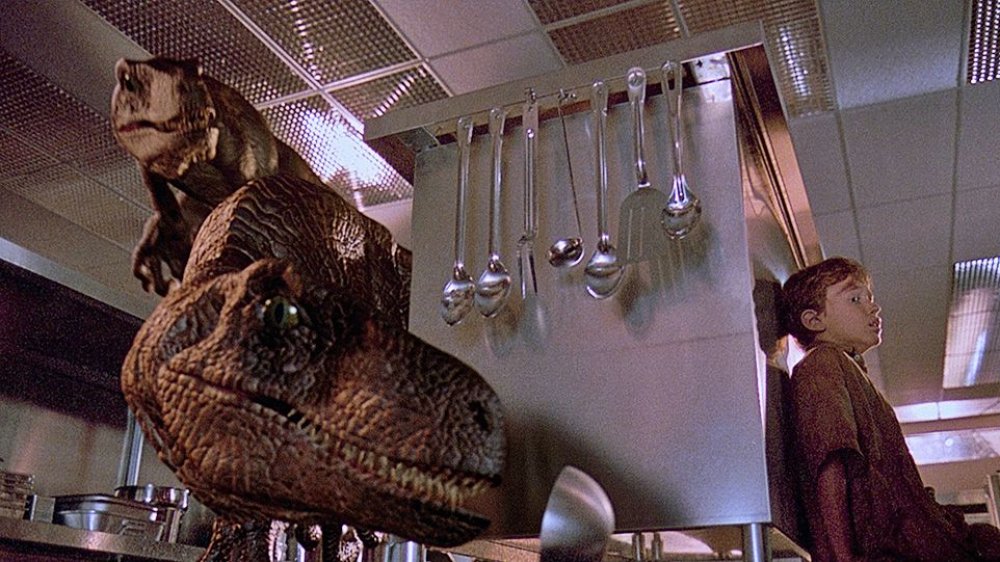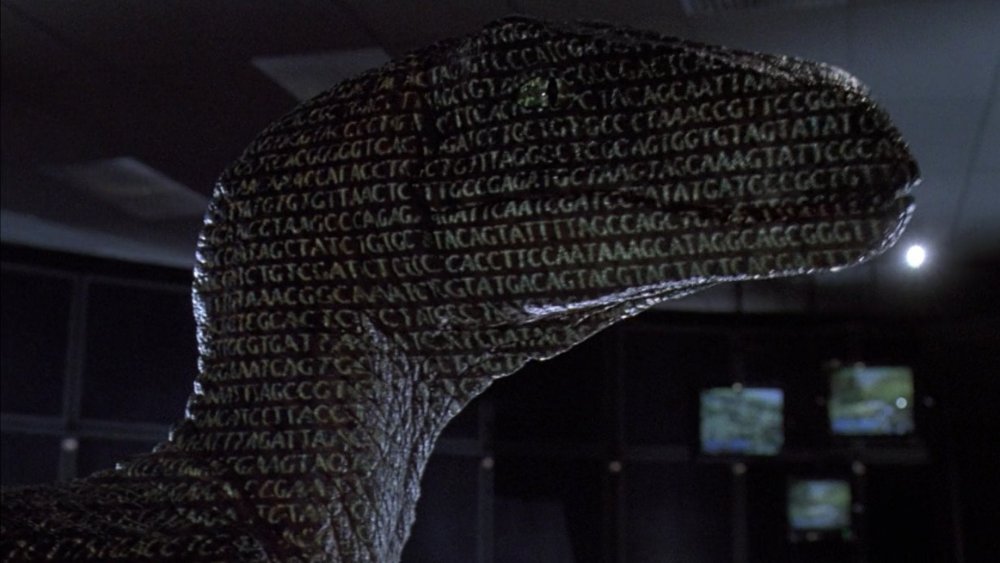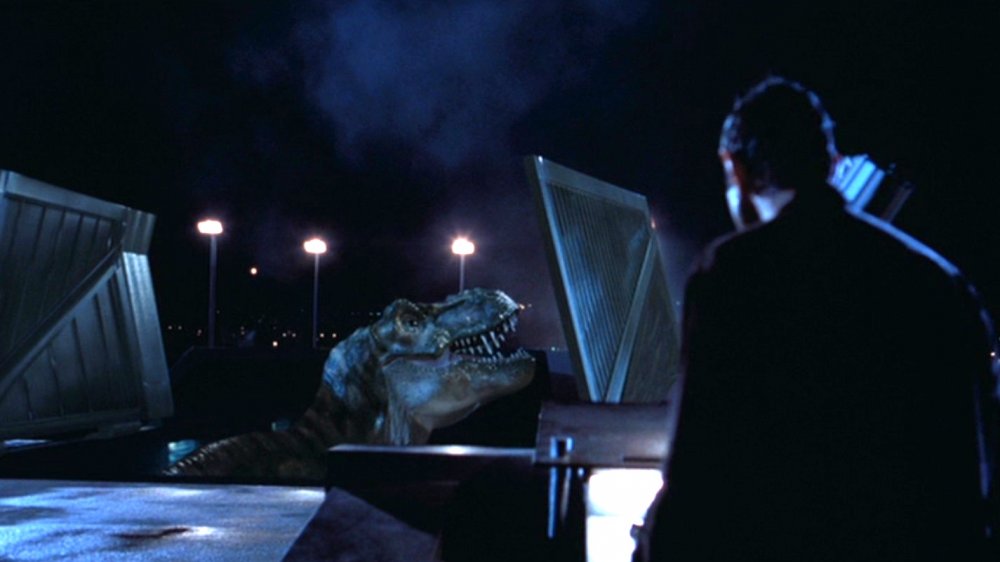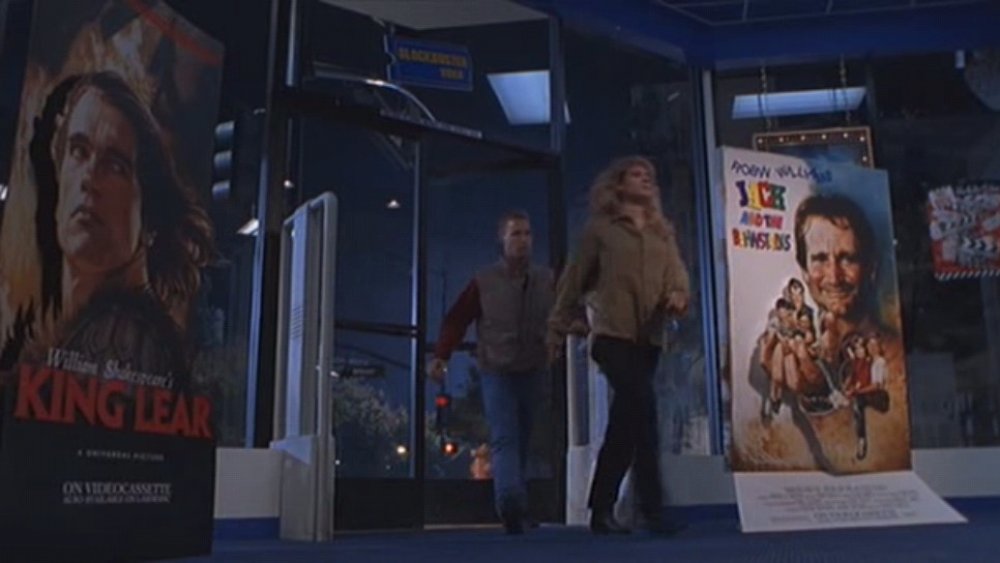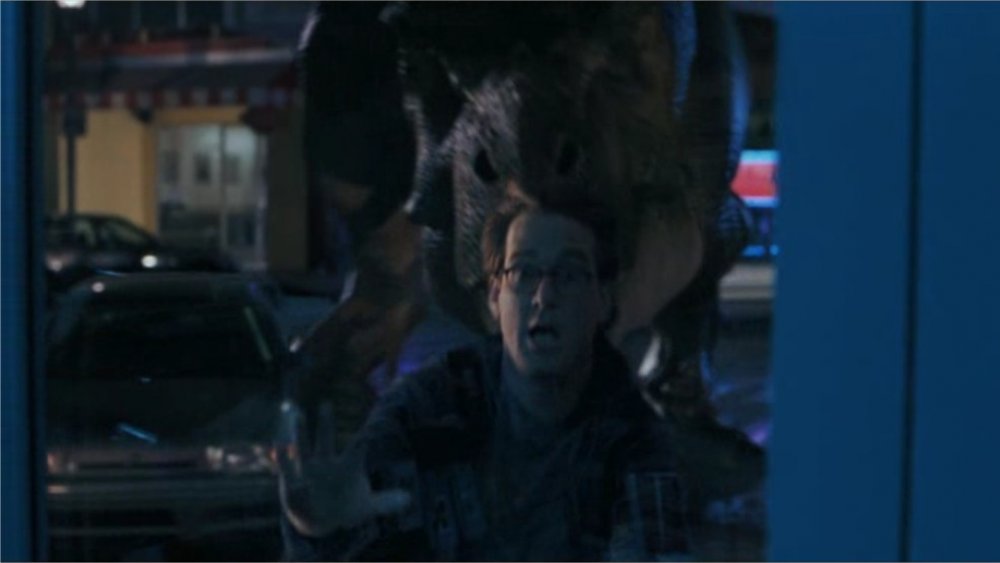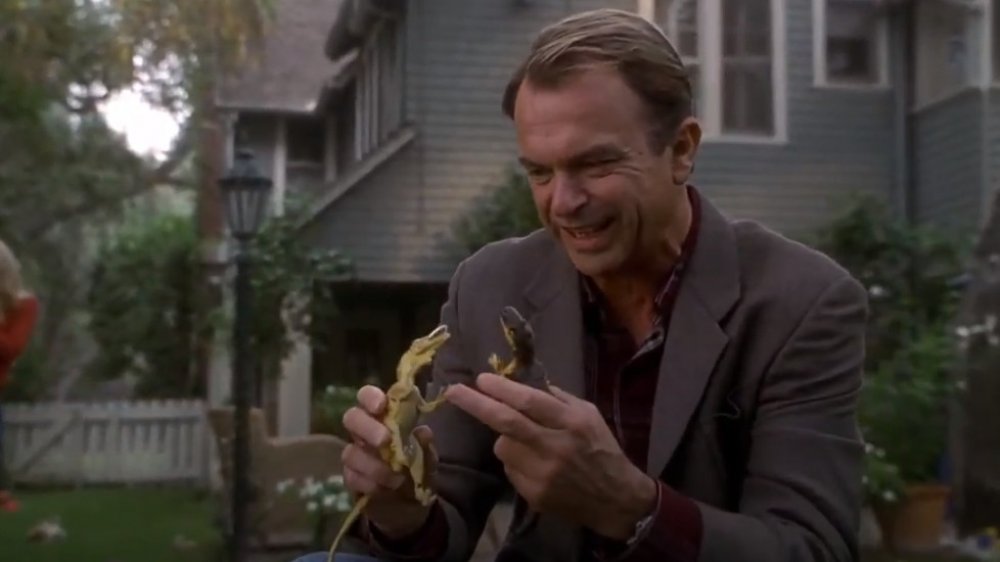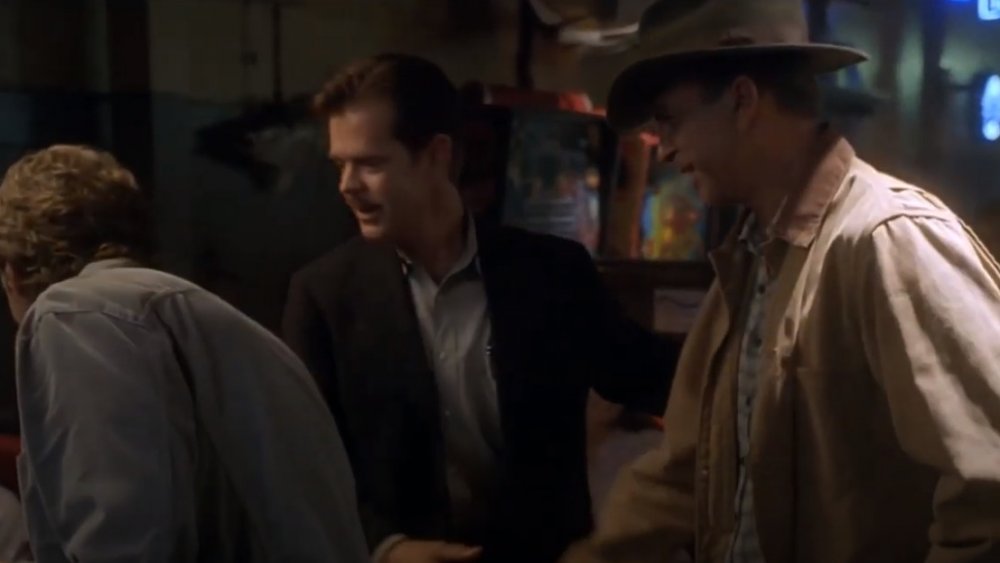Small Details You Missed In The Original Jurassic Park Trilogy
This content was paid for by Netflix and created by Looper.
In 1993, Steven Spielberg was already one of the most popular and accomplished directors of his generation. He helped invent the summer blockbuster with Jaws and then went on to make films like Close Encounters of the Third Kind, E.T. the Extra-Terrestrial, Raiders of the Lost Ark, and more mega-hits. Yet somehow, he still wasn't done breaking the summer movie mold.
That year Spielberg released Jurassic Park, an adaptation of Michael Crichton's novel of the same name, which went on to become the highest-grossing movie ever at the time and spawned a franchise that's still producing new films today. Jurassic Park and its first two sequels — The Lost World and Jurassic Park III — remain staples of every '90s kid's childhood. They're the kinds of movies you can watch over and over, but even if you've done that, we're betting there are some things you probably haven't noticed yet. Well, we're here to help. Here are some of the best small details you never noticed in the original Jurassic Park trilogy.
A clever metaphor
Jurassic Park makes it clear from the very beginning that Dr. Alan Grant is not good with technology. Machines seem to automatically fail around him, and he's much happier digging in the dirt than he is trying to use a computer. When he and Dr. Sattler agree to go to the island with John Hammond, Grant reveals that even seatbelts are an issue for him when he can't seem to find the right two ends to click together. Instead, he takes two "female" ends of two different seatbelts and, frustrated by the whole thing, just ties a knot.
It's a funny moment, but it's also a detail that foreshadows much more. When they finally arrive at Jurassic Park, Grant and Sattler are told that the dinosaurs can't breed because they've all been engineered to be female. Later, Grant finds egg shards in the wild, and realizes that the frog DNA used to make the dinosaurs also allowed them to change their sex so they could breed. So, in essence, two "female" connections found a way to get together and reproduce anyway, just like the seatbelt. As Dr. Malcolm so famously said: "Life finds a way."
Watching movies at work
If there's an actual villain in Jurassic Park aside from dinosaurs who are just following their natural instincts, it's Dennis Nedry, the park's shifty head programmer. The film reveals early on that Nedry, who's fallen on hard financial times, has agreed to steal dinosaur embryos from the park and smuggle them out to be sold to a corporate rival. To do this, he effectively tanks the park's entire system in the middle of a storm, just so he can have a brief window to make his escape.
The kind of chaos Nedry is set to sow in Jurassic Park is foreshadowed in a lot of ways, including the look of his desk. It's an absolute mess, covered with papers and junk food and little toys, but there are also a few clever hints at what's to come hidden there. In one scene, if you look closely at the monitor on the far left of Nedry's desk, you'll see that he has a window open to play Jaws. Jaws was Jurassic Park director Steven Spielberg's breakout film, and a movie some still consider to be the first summer blockbuster. It's also, not coincidentally, a film about the dangers of refusing to listen to experts, and you might also notice that the scene Nedry's watching features Martin Brody tossing chum into the water to draw the shark. Nedry doesn't know it yet, but his actions are about to basically do the same thing with dinosaurs.
The line between science and disaster
From the moment we see him in Jurassic Park, Dennis Nedry is portrayed as a selfish, sloppy, and very abrasive personality. He doesn't seem to care about anyone but himself, and he's not really concerned about what he has to do to other people so long as he gets what he wants.
This is in many ways reflected in the way his desk is laid out. It's covered in junk, which spreads out to the floor around it, and is decorated with various toys that indicate his childishness. But there's something else on Nedry's desk, something that almost looks like someone like him wouldn't have put it there.
Taped to the side of one of his monitors is a photo of J. Robert Oppenheimer, the scientist most commonly remembered as the "father" of the atomic bomb. Like Oppenheimer and his colleagues at the Manhattan Project, the people working at Jurassic Park are part of a massive, paradigm-shifting scientific effort that could have consequences they have not yet dreamed of, many of them incredibly destructive. It's a dark reminder of what's still to come in the film.
John Hammond's bigger plans
A recurring theme throughout Jurassic Park is the way in which John Hammond, emboldened by his own vast wealth and enthusiasm, just keeps barreling through obstacles to accomplish his dream of a dinosaur theme park regardless of the risks. He's convinced, right up until things start to go very wrong, that he has done something magnificent that will soon be a worldwide sensation, and he has the plans to prove it.
In the dinner scene, when Dr. Malcolm first begins to raise concerns about the park, the table is surrounded by various visual displays on the screens around the room. Each of these screens shows us a different part of Hammond's hubris. On one wall, he's projecting a bar graph that shows that he's convinced Jurassic Park will soon be more popular than "sports" as an entertainment commodity. On another, just behind Dr. Sattler, he's projecting his plans for "Jurassic Park Europe," an expansion of the original facility that he's not doubt certain he'll be able to build. Hammond's dreams may have turned into nightmares, but never let it be said that he didn't dream big.
Real book, fake gift shop
Throughout the film, Jurassic Park creator John Hammed is quick to point out just how far he went to design the ultimate dinosaur theme park experience. He frequently tells his guests that he "spared no expense" in putting the park together, and that's reflected in the way the whole thing is laid out. Even aside from all the dinosaurs, Jurassic Park seems to have it all. From world-class dining to elaborate design and a hell of an ice cream stash, the park looks like it might have really been something if it had actually been able to open to the public.
Jurassic Park is so detailed by the time the scientific advisors get there that it even has a fully stocked gift shop, which we see in one of the rare quiet scenes after the chaos begins. As the camera pans past the souvenir t-shirts and stuffed dinosaur toys, it also shows us a book called The Making of Jurassic Park by Don Shay and Jody Duncan. In the film, we can imagine this would be a book commissioned by Hammond to paint a rosy picture of his revolutionary theme park idea, but it was also actually a real book. Spielberg slipped a plug for Shay and Duncan's book, about the making of the movie rather than the park, right into the film.
Nods to another scary classic
Every Jurassic Park fan has their own ideas about what the best dinosaur sequence in the film is, but for a lot of viewers it never gets scarier than the raptor attack in the kitchen. As Tim and Lex wait for Dr. Grant in the visitors center, they find themselves surrounded by the pack-hunting raptors, and retreat into the industrial kitchen. What follows is a sequence packed with suspense, and that suspense includes not one but two different nods to one of Spielberg's favorite directors, Stanley Kubrick.
Because the kitchen in Jurassic Park bears a resemblance to the Overlook Hotel kitchen in Kubrick's adaptation of Stephen King's The Shining, Spielberg built a couple of nods to that film right into the raptor attack. The first comes when Lex hids in a cabinet and uses her reflection in another cabinet to lure a raptor into hitting its head. This is similar to, but not exactly like, a moment in The Shining when Danny hides in a kitchen cabinet to avoid his father. Then there's the moment when Tim lures a raptor into the walk-in freezer so he and Lex can lock it in. Again, it's similar to a moment in The Shining, when Wendy Torrance locks her husband in the pantry after knocking him unconscious. Clearly, Spielberg learned some of his best suspense tricks from a master.
The building blocks of life
Jurassic Park is a story very concerned with DNA, because without it the park itself would not exist. John Hammond's company, InGen, has created something unprecedented by harvesting dinosaur DNA through blood taken from prehistoric mosquitoes. As Mr. DNA explains during his video early in the film, this DNA is then combined with frog DNA to complete the genetic code of the animals, allowing InGen to grow and hatch brand-new dinosaurs in the modern world.
Of course, as soon as Dr. Malcolm starts digging deeper into the scientific implications of what Hammond and company have done, the movie becomes a cautionary tale, and Spielberg finds all kinds of ways to convey those themes. This culminates in the famous raptor attack sequence in the visitors center, when a projector shines a sequence of letters across a raptor's face and neck. The letters are C, G, A, and T, which together represent the building block of DNA: cytosine, guanine, adenine, and thymine. By projecting them directly onto the dinosaur, Spielberg is reminding us that these creatures are not part of the natural order. They are made, not born. They are products, and the people who created them did so irresponsibly.
Tributes to King Kong
Steven Spielberg is a student of film history, and his filmmaking stems for a lifelong love of movies, so of course he packs his films with loving little references to movies he's enjoyed for decades. Since Jurassic Park is a franchise about prehistoric creatures rising to threaten human civilization, it makes sense that Spielberg would draw inspiration from an old favorite: King Kong.
Careful viewers will note that both Jurassic Park and its sequel, The Lost World, feature references to Kong. In the first film, Dr. Malcolm makes a joke about it as their tour vehicles approach the park's gates, which look remarkably similar to the ones in Kong Kong.
"What do they got in there, King Kong?" he jokes as they approach the massive entrance to the park.
In The Lost World, the reference is a bit more subtle but arguably more impactful. The ship that InGen uses to transport that Tyrannosaurus Rex and its baby from Isla Sorna to San Diego is named the Venture, after the ship that brought King Kong to Manhattan in the original film. As it turns out, both voyages were a bad idea.
Movies within movies
Perhaps the most famous sequence in The Lost World: Jurassic Park comes near the end of the film, when an angry T.Rex breaks free of the ship holding it captive and rampages through San Diego. The sequence is packed with big, explosive action moments as well as smaller pieces of humor, and if you watch it enough times you start to notice a lot of little background jokes around all the mayhem.
Some of the most memorable of these jokes comes in the moment when a runaway bus collides with a Blockbuster Video store. Spielberg gives us two views of the store, and both of them contain little jokes. Outside the store, we can see fake posters for King Lear starring Arnold Schwarzenegger (with some fabulous long hair) and Jack and the Beanstalks starring Robin Williams. When the camera cuts inside, we see another fake standee for a film starring Tom Hanks called Tsunami Sunrise. It almost makes you wish you could travel to the dimension where Jurassic Park is real just so you could see the movies.
An unlucky screenwriter
The T. Rex attack on San Diego is full of little memorable moments, from the Japanese men running from the giant monster chasing them through yet another city to the giant "76" ball that goes rolling past Ian and Sarah's car. Of course, as with just about every big dino attack in the franchise, it also includes a very memorable death scene that's actually perhaps a little more important than you realized.
As the crowd on the streets of San Diego flees from the pursuing dinosaur, a man in glasses and a plaid shirt breaks off from the rest of the group and tries to run into a nearby business. We watch as he runs to the glass door, tries to open it, finds it locked, and then finds himself at the mercy of the T. Rex. The dinosaur then scoops him up in its jaws and eventually lays him down behind a car to have him as a snack. That's not just some random T. Rex victim, though. It's David Koepp, the screenwriter behind both Jurassic Park and The Lost World.
Foreshadowing with toys
Dr. Alan Grant is not good with children. This is something we see the moment we meet him in Jurassic Park, when he decides to terrify a boy who's giving him snarky responses to his comments about velociraptors. Over the course of the first film, thanks to all his time hanging out with Lex and Tim, he gets better with kids, but he's never entirely comfortable.
Jurassic Park III returns to the theme of Grant's dynamic with kids with an early scene in which he's playing with Dr. Sattler's young son. The toddler holds up a pair of herbivore dinosaur toys and makes them play fight, while Dr. Grant scoffs. The paleontologist then picks up a pair of carnivore toys and shows the boy that those species are much more likely to fight each other, even though he's not exactly getting through to the toddler holding the cheap pieces of plastic.
The scene is amusing because it reminds us that Dr. Grant is still not great with kids, even though he does make an effort, but it also carries another meaning. By playing with the pair of carnivore toys in the beginning of the film, Grant foreshadows the clash between the Tyrannosaurus and the Spinosaurus in the film's climax.
Jurassic Park in pop culture
Most of the action in the original Jurassic Park trilogy takes place on one of the two islands where the park originated, with very little plot unfolding back in the modern world. Still, if you pay attention, you start to notice certain things about the way the parks, despite never opening to the public, have impacted society. In The Lost World, of course, InGen is still trying to pretend Jurassic Park isn't real, but by Jurassic Park III the cat is out of the bag on that. The whole world knows that dinosaurs were bred on islands, even if people like Dr. Grant are no longer willing to talk about them.
Even though Isla Sorna is still home to dinosaurs, it's not really open to the public, but that hasn't stopped people from talking about it. Jurassic Park III opens with a pair of tourists attempting to parasail around the island to see dinosaurs, and the sense of wonder about the place has expanded into the real world. When Dr. Grant goes into the bar to meet with the Kirbys about their trip, careful viewers can spot a Jurassic Park pinball machine in the room.
